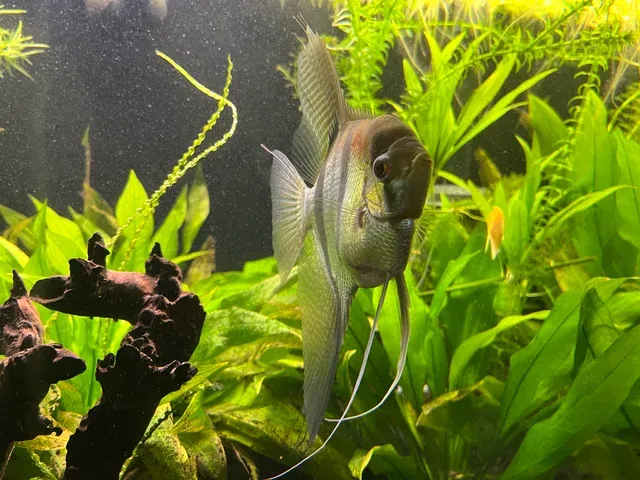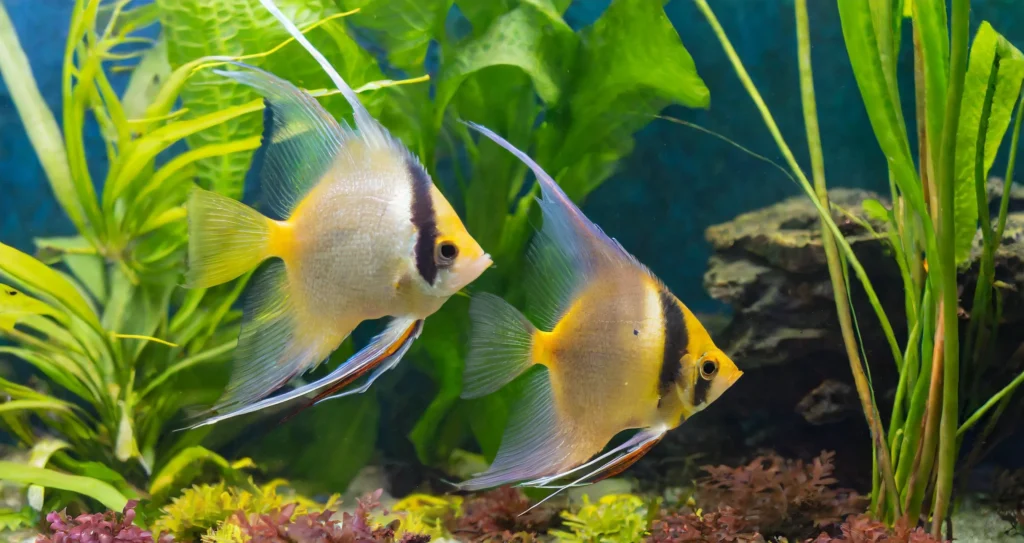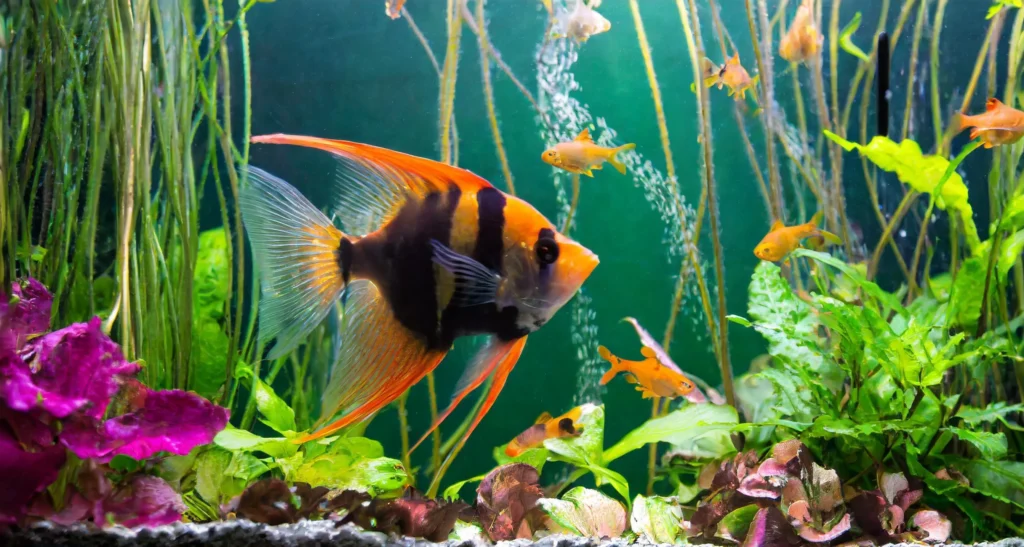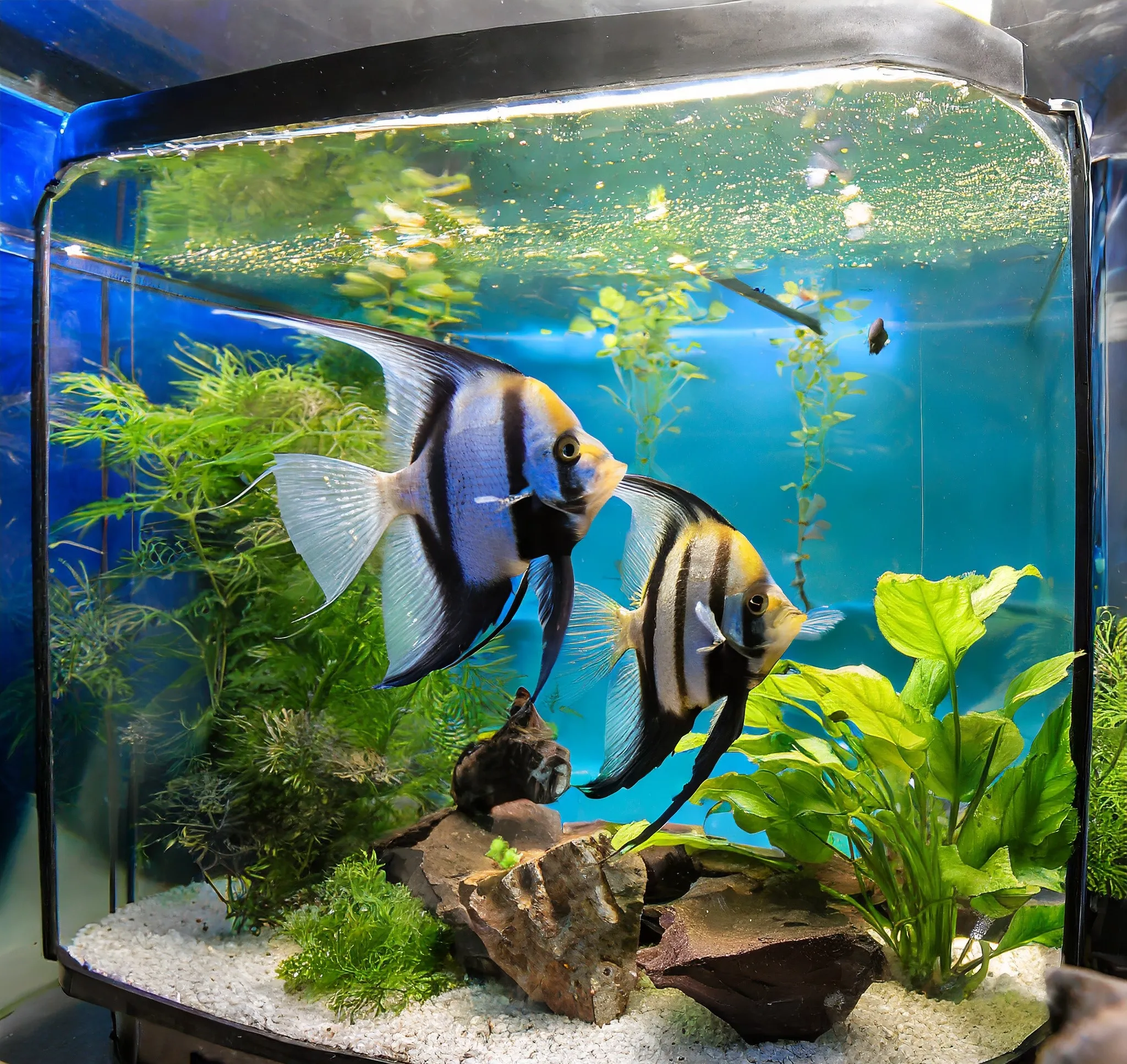Determining the minimum tank size for angelfish is key to keeping these freshwater fish healthy and thriving. With their elegant fins, vibrant colors, and personalities, angelfish are popular but require adequately sized tanks to truly flourish. But what exactly is the minimum tank size for an angelfish? This beginner’s guide will cover the factors impacting minimum tank size recommendations for housing one or a pair of angelfish. We’ll explore how many gallons a single angelfish needs versus a bonded duo to establish their minimum tank size needs. By understanding optimal tank sizing for angelfish, you can provide the right freshwater habitat for their well-being.
Selecting the proper tank size is one of the most important factors for keeping angelfish healthy and comfortable in captivity. While angelfish may seem small, they require surprisingly spacious aquariums to thrive.
Minimum Tank Size for One Angelfish.

For a single adult angelfish, most aquarists recommend a bare minimum tank size for angelfish is 20 gallons. A standard 20 gallon long tank with dimensions of 30” x 12” x 12” can temporarily house one angelfish. However, this small size should only be considered for juvenile, short-term housing.
To allow an angelfish to thrive long-term, aim for a 29-55 gallon tank for a single specimen. This additional space better accommodates their long, elegant fins and continuous swimming habits. It also satisfies their territorial needs.
In tanks smaller than 29 gallons, angelfish suffer from cramped conditions that cause chronic stress, appetite suppression, poor growth, and inhibited natural behaviors. Without adequate room to roam, they cannot exhibit their full graceful beauty.
Several key factors influence the ideal single angelfish tank size:
- Adult Size – Angelfish can grow over 6 inches long, requiring substantial swimming elbow room.
- Activity Levels – Angelfish swim at all tank levels continuously and need space to move about.
- Territorial Nature – Even lone angelfish appreciate ample territory for security and comfort.
When setting up a tank for one angelfish, choose a rectangular footprint and avoid dense decor that blocks free swimming lanes. Give your solo angelfish the spacious home it needs to thrive.
Factors Influencing Minimum Tank Size For One Angelfish.
The required minimum tank size for one angelfish is influenced by several key factors. Such as:

- Adult Size – Angelfish can grow quite large, up to 6 inches in length for unmodified wild types. Even selectively bred angelfish can reach 4-5 inches. Larger fish need more swimming room.
- Swimming Patterns – Angelfish are laterally compressed fish that swim primarily in the middle and upper levels of the tank. They need adequate length and height for comfortable swimming.
- Behavior – Angelfish are cichlids and can be territorial, especially during spawning. They need space to establish distinct territories and retreats.
- Water Quality – Large water volumes are more stable and forgiving of water parameter fluctuations. Bigger is better for maintaining water quality.
- Group Size – Angelfish do best in small groups. A larger tank is needed to house multiple angelfish and reduce aggression and territoriality.
- Tankmates – Angelfish may be housed with compatible tankmates. A larger tank provides room for other fish while minimizing aggressive encounters.
- Decor – Angelfish appreciate plants, driftwood, rockwork and other decorations. A bigger tank provides more room for an enriched habitat.
Minimum Tank Size for Two Angelfish.
Keeping multiple angelfish together mandates an even larger tank to diffuse aggression and accommodate breeding behaviors. The minimum tank size for two angelfish is 55 gallons. However, a 75+ gallon tank is better to maintain harmony.

In too small a tank, two angelfish inevitably become hostile as they competitively establish territories and spawn. The cramped space also causes chronic stress that results in illness.
Some key reasons more space is essential for angelfish pairs include:
- Distinct Territories – A bonded male and female claim separated tank areas.
- Breeding Displays – Courting and spawning require considerable open areas.
- Avoiding Conflict – Extra gallons ease clashes over preferred territory.
Use a long tank footprint to designate clear zones for each fish. Break up sightlines with plants and decor as well. Watch for aggressive nipping, chasing, or fighting which signals too small a tank.
For a community tank with multiple angelfish, allow at least 20 gallons per fish. Heavily plant the aquascape to establish distinct domains and diffuse territorial disputes.
Tank Configuration Tips and Precautions.
When housing a bonded pair, it is crucial to ensure a well-planned tank layout that includes hiding spots and territories for each angelfish. Adding live plants, wood, and rocks can provide visual barriers and mimic their natural environment. Care must be taken to prevent aggression between the pair and reduce stress levels.
Complete Guide On Angelfish Care.
Influencing Factors on Minimum Tank Size For Angelfish.

While general guidelines exist for tank sizes, it’s important to consider the specific needs of different angelfish varieties. Factors such as adult size potential and swimming and movement patterns can influence the requirements of tank size for angelfish.
The minimum tank size for angelfish can be influenced by various factors. While general guidelines exist, it is important to consider the specific needs of different angelfish varieties.
One factor to consider is the adult size potential of the angelfish. Different varieties of angelfish can reach different sizes as adults. For larger angelfish varieties, a larger tank size may be necessary to provide enough space for them to swim and move comfortably.
Another factor to consider is the swimming and movement patterns of angelfish. Some angelfish varieties are more active and may require a larger tank with open swimming space, while others may be more sedentary and can thrive in a smaller tank with more hiding places.
It’s important to research the specific needs and requirements of the angelfish variety you intend to keep and provide them with a tank size that meets their needs for space and movement.
Optimizing Angelfish Tank Layout and Maintenance
In addition to size, angelfish tanks must also be properly arranged and maintained:
- Add driftwood, live plants for territorial markers and hiding spots.
- Use a powerful filter sized for tank capacity to keep water pristine.
- Install a heater and thermometer to maintain 78-82°F water temperature.
- Perform 25% weekly water changes and test pH, ammonia, nitrites regularly.
- Establish a nitrogen cycle before adding fish to build up beneficial bacteria.
- Use a rectangular tank footprint for maximum swimming lanes.
- Position decor and plants to keep open swimming space.
With careful attention to tank size, layout, and upkeep, you can create a comfortable and enriching habitat suited specifically for your angelfish.
Read More: Complete Angelfish Tank Setup Guide.
Common Angelfish Tank Size Mistakes to Avoid
Some key tank size errors that compromise angelfish health include:
- Undersized tanks that restrict movement and growth.
- Overcrowding too many angelfish or incompatible tankmates.
- Cluttering the tank heavily with decor over swimming space.
- Allowing water conditions to deteriorate through lack of maintenance.
- Assuming juvenile angelfish can remain in small tanks as adults.
Be vigilant against these issues to ensure your angelfish live long, healthy lives in a properly sized home. Correct any housing deficiencies as soon as they become apparent.
FAQs.
What is the minimum tank size for angelfish?
For one adult angelfish, the minimum tank size is 20 gallons but 29-55 gallons is ideal. For a pair, provide at least 55 gallons.
What dimensions should an angelfish tank have?
Angelfish benefit from a rectangular tank footprint that is longer than tall, providing more horizontal swimming space.
How many angelfish can be kept together in a 55 gallon tank?
A 55 gallon tank can comfortably house a bonded pair of angelfish. Groups larger than that may lead to territorial aggression in 55 gallons.
Do different types of angelfish have different tank size needs?
Yes, larger angelfish varieties need more space than miniature or dwarf species. Also account for temperament differences.
Should I upgrade my angelfish tank size as they grow?
It’s recommended to upgrade to a larger tank every 1-2 years as juvenile angelfish mature to adulthood to ensure adequate space.
What are signs that my angelfish tank is too small?
Lack of appetite, lethargic swimming, hiding, aggression, stunted growth, and disease susceptibility can indicate a tank size is too small.
How often should I clean an angelfish tank?
Aim to perform 25% partial water changes weekly, vacuuming the substrate and cleaning filter media monthly.
What water parameters are ideal for angelfish?
Angelfish do best in soft, acidic water between pH 6-7.5, temperatures of 78-82°F, and low ammonia/nitrites.
Conclusion
While angelfish appear small, they require roomy aquariums with 20+ gallons for singles and 55+ gallons for pairs. This spacious housing accommodates their active swimming and territorial tendencies. Beyond tank size, also optimize layout and upkeep for healthy angelfish. Give them the properly-sized home they deserve, and enjoy their grace and vibrancy shine through!

